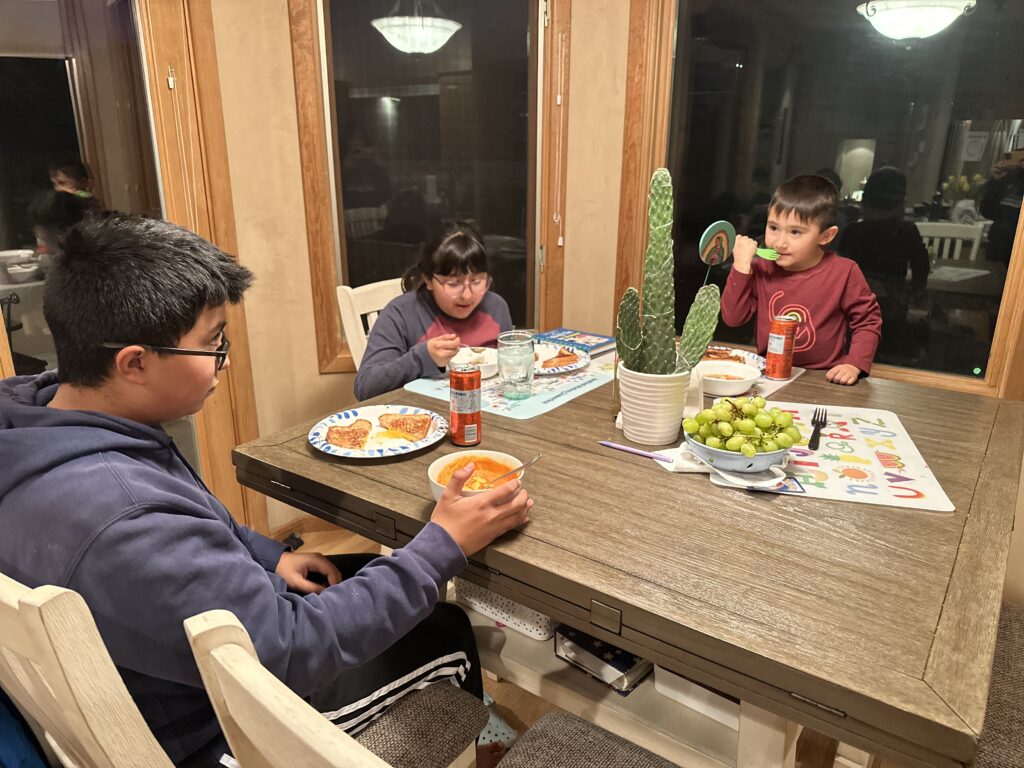Food for Thought
How your busy family can feed your kids and not feel bad about it
By Sonya Paiz
Eating healthy can be hard for all of us! When you add kids and a busy schedule to the mix, providing a healthy meal at home or on the go can seem impossible. Feeding a family can seem very complicated—especially when every member can have very different needs. I have three children, and we are always running to and from school, practices, birthday parties, and friend hangouts. To make things extra challenging is their ages and needs. I have a 13-year-old son, a 10-year-old daughter and a 4-year-old preschooler. My teenage son has a huge appetite, whereas my preschooler eats much smaller portions but also likes to snack. Trying to balance different kids and their needs can be a full-time job. We read and hear so much information on eating well, trendy diets, how much to exercise, and what to look out for that it is often too much information to understand and figure out what advice to follow. When it doesn’t work out perfect or even halfway perfect, it can feel like the ultimate failure for parents who are trying their best.
What are the guidelines?
Each age group or life stage has different guidelines, based on their calorie needs and typical intake. Starting with toddlers, they have very small stomachs and generally eat a few tablespoons of each food group at each sitting. They often state they aren’t hungry at mealtimes and prefer snacking. The strategy for this group is to remember that they only need a few tablespoons of each food group to feel full—this looks very minimal to most parents. Snacks are very important, and the types of snacks are too. Some snack ideas for toddlers could be yogurt, cheese and pretzels or crackers, applesauce, fruit, and veggies and hummus. Having a snack schedule is also helpful, so that they are ready to eat at mealtimes instead of snacking all day. Children this age will probably look to eat a meal or snack every two to three hours. Preschool-age children have similar eating schedules, with a slightly longer stretch between meals. My 4-year-old generally looks for a meal or a snack every three hours. In general, the parents provide the options and the children select what and how much they want to eat. The exception is candy and sweets: This should be portion controlled.
School-age children are often dependent on their school for lunchtime and will have snacks during recess and afterschool. I find that my 10-year-old child will eat breakfast around 7, have a snack during recess at 9:40, and then eat lunch at 11:40. When she gets home at 2, she is starving and will eat a snack or small meal and then be ready for dinner at 6. My 13-year-old eats breakfast at 7, his lunch is at 10:30, he will often eat snacks in the afternoon between classes and then eat right after school at 3, and then dinner at 6. His appetite is shockingly huge, but teenagers need a large amount of calories to support their overall growth and development.

Making it easy. With so many different age ranges and needs not including the grown-ups, how do we make this work for a busy family? There are some basic guidelines that you can count on.
Include a fruit and/or vegetable with each meal and as snacks. A great way to get kids to eat more produce is to role model eating them with meals and snacks.
Include kids in grocery shopping. I have my kids help pick the meals they want to eat for the week. They also get to pick the veggies they want to include with dinner and their lunches. I generally pick the fruits for the week based on their likes, what’s in season, and what is affordable. I try to pick a variety of veggies and fruits that can vary throughout the week, so we have less of a chance for things to go bad. For example, when I buy produce I often purchase berries (blueberries, strawberries, raspberries, blackberries), bananas, apples, oranges, pears and grapes. These are usually in our home regardless of the season.
Make them accessible. I wash the berries and grapes and make them easy to access. With my kids, I know that if I get them washed and ready to eat, fruit is their go-to snack. We finish off the week with apples and oranges, since they have a longer shelf life.


Keep kids involved. Many parents have a hard time getting their kids to eat vegetables. Having your kids be involved with preparing meals and selecting what they want to eat from already preselected choices can be helpful. For example, give them a choice between broccoli and green beans. I also purchase a variety of vegetables—fresh and frozen—to ensure we have a solid vegetable option always available. I try to plan our meals so that the fresh vegetables get cooked and consumed first and then fall back on the frozen vegetables. For dinner time, my kids are often in charge of making the vegetables. We use steamer-bag veggies and they love helping with the microwave and getting the food plated for the meal. For lunch we keep baby carrots, cucumbers, bell peppers, and cherry tomatoes on hand. The kids again are allowed to select what vegetables and fruits they would like to have in their lunch. Since all of our meals and snacks are presented in the same way, my kids will often self-select a fruit and/or something with it anytime they are looking for something to eat.
Balance is the key. My meals and lunches also follow this eating pattern so we are all eating similarly and balanced. I follow the MyPlate Method for our family. When I plate my lunch or dinner, it generally includes half a plate of vegetables. Then I split the other part of the plate between my protein and starch. Their plate is split similarly with smaller portions. We often have fruit at the end of the meal as the sweet finisher. But my children are also crazy for sweets and candy. For this we practice portion control. Our rule is only one sweet treat per day. Some days we do great with this and other days it’s a real struggle.
We use these same principles when we are not eating at home. Since we practice this way of eating all the time, it makes it easier for the kids to make food selections when they are not at home. Since they do a pretty decent job of eating balanced, I am less concerned if they pick less health options when out to eat. I also try to stock up on snacks so that we are not ruled by hunger and lack of choices. My hope is that practicing making balanced choices and not labeling any foods as good or bad will help my children have a healthy relationship with food. Also when days don’t go according to plan or we miss the mark on our fruit and vegetable goals, we aim to fix the next meal or snack and move on.
Sonya Paiz is a registered dietitian and certified diabetes care and education specialist. She works for the University of New Mexico Hospital as the director of the Center for Diabetes and Nutrition Education. She is passionate about nutrition education and helping people. She was born and raised in New Mexico and lives in Albuquerque with her family.








